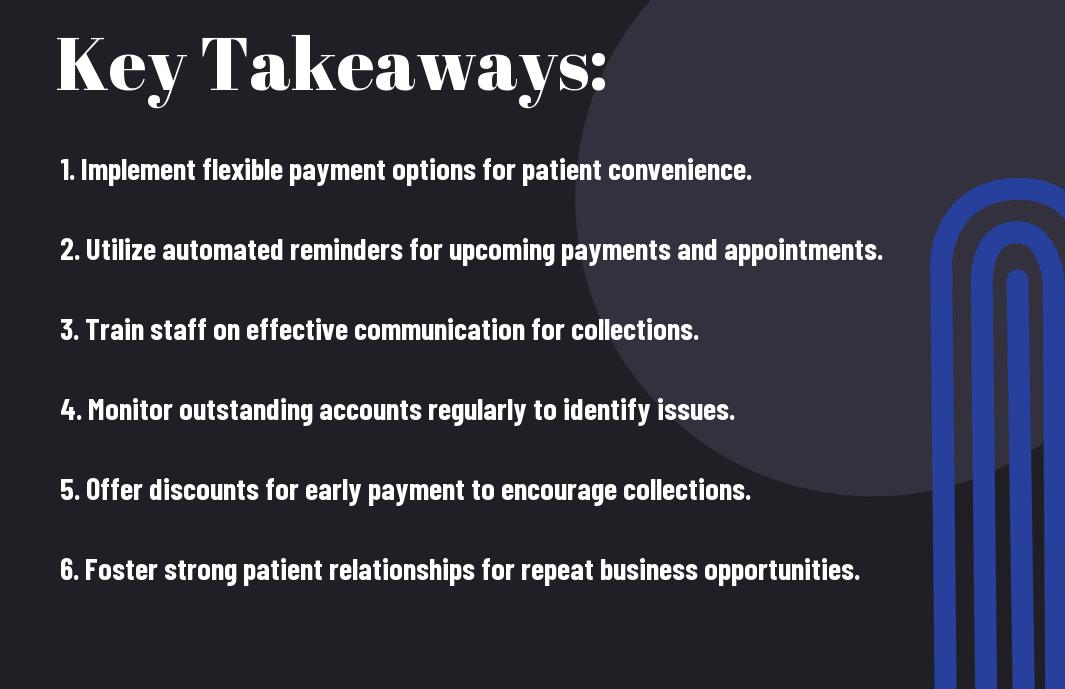Proven Ways to Maximize Revenue in Your Dental Practice
Most dental practices struggle with ineffective collections, which can significantly impact your bottom line. As I investigate into the proven techniques to enhance your collections, I aim to provide you with actionable strategies that will boost revenue and help you maintain a healthy cash flow. You’ll learn how to improve patient communication, streamline billing processes, and utilize technology to ensure that each service is appropriately compensated. By implementing these techniques, you can create a more financially stable practice while focusing on what you do best – providing exceptional care.

Key Takeaways:
- Implement efficient appointment reminders and confirmations to reduce no-show rates and enhance patient attendance.
- Utilize flexible payment plans and financial arrangements to accommodate patients’ needs and improve collection rates.
- Automate billing and collection processes to streamline operations and minimize administrative burden on the practice.
- Educate patients on their insurance benefits and available treatment options to promote understanding and acceptance of services.
- Regularly review and analyze collection metrics to identify trends and areas for improvement within the practice’s financial performance.

Understanding Revenue Cycle Management
A successful dental practice relies heavily on the understanding of Revenue Cycle Management (RCM). RCM encompasses all the administrative and clinical functions that contribute to the capture, management, and collection of patient service revenue. By streamlining these processes, I can ensure that my practice operates efficiently, ultimately improving patient satisfaction and boosting profitability.
Key Components of Revenue Cycle
Revenue cycle management consists of several key components, including patient registration, insurance verification, charge capture, claims submission, and collections. Each of these elements plays a vital role in ensuring that you are compensated for the services provided. By focusing on optimizing these components, I can enhance my practice’s revenue and elevate the overall patient experience.
Common Challenges in Collections
Cycle management can present several challenges in collections, particularly in adhering to various billing regulations and navigating the complexities of insurance claims. I often face obstacles such as delayed payments, denied claims, and insufficient patient communication, which can hinder cash flow and profitability. Understanding these common issues is vital to developing effective strategies for improvement.
Collections can be challenging due to a variety of factors. Delayed payments from insurance companies and patients can significantly impact cash flow. Additionally, claim denials are often linked to incomplete documentation or incorrect coding, which can create further bottlenecks. Furthermore, ineffective communication with patients about their financial responsibilities may lead to misunderstandings and unmet expectations. By addressing these issues head-on, I can implement solutions that improve my practice’s overall financial health.
Strategies for Enhancing Patient Communication
Now, effective communication with patients is vital for boosting collections in your dental practice. I recommend implementing strategies that foster transparency and trust. By utilizing resources like Dental billing and patient collections: 7 ways to get paid …, you can streamline the billing process and improve patient satisfaction.
Importance of Pre-Appointment Communication
With clear and concise pre-appointment communication, you set the stage for a successful patient experience. Informing patients about their upcoming visits, including any necessary preparations or financial obligations, can reduce anxiety and increase their willingness to engage in treatment plans. This proactive approach ultimately leads to enhanced revenue as patients feel more informed and are less likely to miss appointments.
Post-Treatment Follow-Up Techniques
PostTreatment follow-ups are an opportunity to reinforce relationships and ensure timely payment. I find that following up with patients after their treatment shows that you care about their well-being and success. This not only encourages them to return for future treatments but also facilitates the collections process.
It’s vital to establish a process for timely follow-ups, whether via phone, email, or text. After treatment, reach out to patients to check on their progress, address any concerns, and remind them of outstanding payments. This personal touch can reinforce a positive experience and encourage timely payments, leading to a healthier cash flow for your practice. By maintaining open lines of communication, you also enhance patient loyalty and satisfaction, making them more likely to refer others to your practice.

Streamlining Billing and Payment Processes
Keep your focus on efficiency to enhance collections in your dental practice. Streamlining billing and payment processes not only accelerates transactions but also reduces the potential for errors that could hinder revenue. Implementing best practices in these areas will lead to improved cash flow and patient satisfaction, ensuring that your practice runs smoothly.
Implementing Efficient Billing Systems
An efficient billing system is foundational to your practice’s financial health. By adopting automated billing solutions, I can minimize manual errors and streamline the invoicing process. This allows you to send out billing statements promptly, ensuring that your cash flow remains steady and that patients receive timely reminders of their obligations.
Offering Flexible Payment Options
Streamlining your payment collection also involves presenting patients with flexible payment options. This adaptability not only accommodates varying financial situations but also promotes timely collections. When patients have the chance to choose from various payment plans, they are more likely to meet their financial commitments.
Also, providing flexible payment options such as monthly payment plans, credit card installments, or even third-party financing can significantly increase the likelihood of collection. Many patients appreciate the freedom to pay in a way that suits their budget. By allowing choices, you reduce the barriers to acceptance and ensure more patients proceed with treatments. This strategy keeps your practice profitable while fostering patient loyalty.
Utilizing Technology for Improved Collections
Despite the challenges faced in dental practice revenue cycles, leveraging technology can significantly enhance collections. By implementing modern solutions, I can streamline processes, reduce human error, and improve patient payment experiences, ultimately leading to improved cash flow and revenue generation.
EHR and Practice Management Systems
Technology has revolutionized the way I manage patient information and collections. Electronic Health Records (EHR) and practice management systems enable me to track patient accounts, sending automated reminders for outstanding bills, which helps to minimize overdue payments and maintain consistent cash flow.
Payment Processing Solutions
The implementation of efficient payment processing solutions is integral to optimizing collections. With options like mobile payments and online portals, I provide my patients with the flexibility to settle their bills conveniently, which not only enhances their experience but also reduces the likelihood of late payments.
In addition, utilizing secure payment processing methods ensures that I protect sensitive patient data while facilitating collections. By offering diverse payment options such as credit cards, automated bank drafts, and digital wallets, I can cater to various patient preferences. This flexibility can lead to a higher collection rate, as fewer patients encounter barriers when settling their accounts. Emphasizing security and convenience in my payment solutions cultivates trust and encourages prompt payments, ultimately benefiting my practice’s financial health.
Training Staff for Success
Your dental practice’s success hinges on how well your staff understands and executes the collections process. Ongoing training equips them with the skills needed to optimize collections efficiently. I encourage you to explore 5 Opportunities to Refine and Improve Your Dental Practice … to enhance your billing strategies.
Importance of Staff Training
Any practice that invests in staff training positions itself for enhanced patient relations and increased revenue. Trained staff can navigate financial discussions more confidently, leading to better collections outcomes.
Best Practices for Collection Training
With a structured training program, I recommend focusing on role-playing scenarios and educating your staff on effective communication techniques. Regular workshops can introduce new strategies and reinforce best practices, ensuring everyone is on the same page.
Success in collections leads to improved cash flow for your practice. Prioritize ongoing education for your team to build confidence when discussing fees and payment options. Utilizing technology for automated reminders can bridge the gap between appointments and collections. A supportive environment where staff are encouraged to share experiences fosters learning and growth. Investing in training isn’t just about today’s collections; it’s about setting your practice up for long-term financial health.
Measuring and Analyzing Collection Performance
Many dental practices overlook the importance of measuring and analyzing collection performance. By implementing a structured approach, you can gain valuable insights into your revenue cycle. I recommend regularly reviewing collection rates and identifying trends or discrepancies. This allows you to make informed decisions, optimize processes, and ultimately maximize your practice’s revenue potential.
Key Performance Indicators (KPIs)
At the core of evaluating your collection performance are Key Performance Indicators (KPIs). These metrics, such as average collection per patient and days in accounts receivable, provide a snapshot of your financial health. To make data-driven decisions, I suggest you continuously track these KPIs, which can guide improvements in your practice’s collection efficiency.
Continuous Improvement Strategies
Beside monitoring KPIs, ongoing improvement strategies are imperative to enhance your collection efforts. Implement routine training for your staff on best billing practices and patient communication, and regularly evaluate your collection policies. Staying proactive in these areas can lead to significant advancements in your practice’s financial performance.
Consequently, adopting a continuous improvement mindset is vital for long-term success in collections. By conducting regular audits and gathering feedback from patients about their billing experience, I can identify specific areas for enhancement. This approach not only improves patient satisfaction but also increases your collection efficiency. By fostering an environment of awareness and adaptation, I can better respond to challenges, uncover new revenue opportunities, and ultimately ensure my practice thrives in a competitive landscape.
Conclusion
With this in mind, I encourage you to adopt these proven techniques to enhance collections in your dental practice. By implementing strategic billing practices, utilizing technology effectively, and fostering excellent patient relationships, you can significantly maximize your revenue. These methods not only improve your financial health but also contribute to a more seamless experience for your patients. When you take proactive measures to optimize your collections, you set your practice up for sustained growth and success.
FAQ
Q: What are some effective strategies for enhancing collections in a dental practice?
A: Some effective strategies include setting clear payment policies, offering flexible payment options, utilizing automated reminders for appointments and payments, providing education on the importance of regular dental care, and ensuring that staff are trained to handle financial discussions delicately and effectively.
Q: How can we improve patient communication regarding financial matters?
A: Improving patient communication can be achieved by having transparent discussions about costs at each appointment, providing a detailed breakdown of treatment costs, creating easy-to-understand financial policies, and training staff to discuss payment options confidently. Regular follow-ups via phone or email can also reinforce these discussions.
Q: What role does patient education play in enhancing collections?
A: Patient education is vital as it helps patients understand the necessity of dental treatments and their long-term benefits. When patients are informed about their oral health and the financial implications of neglecting care, they are more likely to prioritize treatments and adhere to payment schedules, ultimately leading to improved collections.
Q: Are there specific tools or software that can assist in maximizing revenue?
A: Yes, there are various dental practice management software tools available that can streamline billing processes, send automated appointment and payment reminders, and track outstanding accounts. Some tools even integrate patient education resources and offer reporting features to analyze collections trends effectively.
Q: How can creating payment plans help in increasing patient compliance with payments?
A: Creating tailored payment plans allows patients to spread the cost of treatment over a manageable period, making it easier for them to afford necessary services. This approach not only encourages patients to follow through with recommended treatments but also minimizes financial stress, leading to higher collection rates for the practice.
Q: What should be included in a written financial policy for dental practices?
A: A robust financial policy should include clear terms regarding payment expectations, accepted payment methods, consequences for late payments or missed appointments, insurance filing procedures, and information about financing options. This clarity helps set patient expectations and can improve compliance with payment protocols.
Q: How can staff training impact the success of collections in a dental practice?
A: Staff training can significantly impact the success of collections by equipping team members with the skills needed to communicate effectively about finances. Training staff to navigate conversations regarding costs, treatment necessities, and payment policies enhances their ability to address patient concerns and reduces hesitation around financial discussions, leading to improved collection outcomes.


